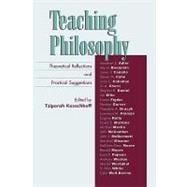
| Acknowledgments | xiii | ||||
| Introduction Tziporah Kasachkoff | xv | ||||
| Part I. Introducing Students to Philosophy | |||||
|
1 | (3) | |||
|
|||||
|
|||||
|
4 | (14) | |||
|
|||||
|
|||||
|
18 | (8) | |||
|
|||||
|
|||||
| Part II. Helping Our Students Improve | |||||
|
26 | (5) | |||
|
|||||
|
|||||
|
31 | (17) | |||
|
|||||
|
|||||
|
|||||
|
|||||
|
|||||
|
48 | (13) | |||
|
|||||
|
|||||
| Part III. Teaching Applied Ethics | |||||
|
61 | (13) | |||
|
|||||
|
|||||
|
74 | ||||
|
|||||
|
|||||
| Part IV. Teaching Philosophy with Computers | |||||
|
83 | (15) | |||
|
|||||
|
|||||
| Part V. Teaching Aesthetics | |||||
|
98 | (13) | |||
|
|||||
|
|||||
| Part VI. Teaching Philosophy of Religion | |||||
|
111 | (13) | |||
|
|||||
|
|||||
|
124 | (10) | |||
|
|||||
|
|||||
| Part VII. Teaching Critical Thinking | |||||
|
134 | (8) | |||
|
|||||
|
|||||
|
142 | (7) | |||
|
|||||
|
|||||
| Part VIII. Teaching Philosophy through History | |||||
|
149 | (13) | |||
|
|||||
|
|||||
| Part IX. Teaching Kant/Teaching Hegel | |||||
|
162 | (5) | |||
|
|||||
|
|||||
|
167 | (4) | |||
|
|||||
|
|||||
|
171 | (11) | |||
|
|||||
|
|||||
|
182 | (5) | |||
|
|||||
|
|||||
| Part X. Teaching Existentialism/ Teaching Continental Philosophy | |||||
|
187 | (10) | |||
|
|||||
|
|||||
|
197 | (10) | |||
|
|||||
|
|||||
| Part XI. Teaching Philosophical Explanation | |||||
|
207 | (25) | |||
|
|||||
|
|||||
| Part XII. Teaching Philosophy of Gender | |||||
|
232 | (20) | |||
|
|||||
|
|||||
| XIII. Looking at What We Do in the Classroom | |||||
|
252 | (12) | |||
|
|||||
|
|||||
|
264 | (13) | |||
|
|||||
|
|||||
| About the Contributors | 277 | (4) | |||
| About the Editor | 281 |
The New copy of this book will include any supplemental materials advertised. Please check the title of the book to determine if it should include any access cards, study guides, lab manuals, CDs, etc.
The Used, Rental and eBook copies of this book are not guaranteed to include any supplemental materials. Typically, only the book itself is included. This is true even if the title states it includes any access cards, study guides, lab manuals, CDs, etc.